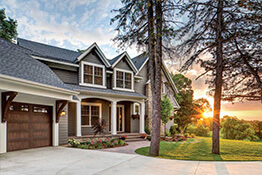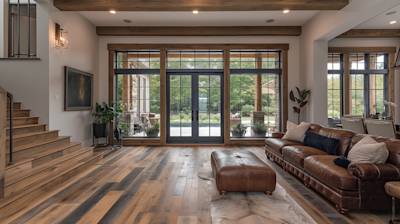Understanding the ins and outs of standard door size can be a game-changer when it comes to home improvements, remodeling, or simply purchasing new doors. With several sizes at your disposal, choosing can feel daunting, especially when you have no inkling about what these sizes mean and why they matter. This comprehensive guide to standard door sizes will leave you better equipped to tackle your next project.
Importance of Knowing Standard Door Size
Before we delve into the specifics of standard door sizes, it is crucial for us to understand why they are important. Here's are the reasons:
-
Your knowledge about standard door sizes can save you potential installation and fitting issues by ensuring a perfect fit.
-
Understanding the different sizes enhances your choice flexibility - from more aesthetics to improved functionality.
-
A verified standard door size is essential when planning space and layout in architectural designs.
-
Knowing the correct door size aids in estimating the cost of a home renovation project-
Standard Interior Door Sizes
Interior doors come in various shapes and sizes, each designed for a specific purpose. Let's discuss the most commonly used sizes for standard interior doors in the US.
Standard Interior Passage Doors
These are the doors you'll typically find in most parts of the house like the living room, bedrooms, and dining room. The standard width for interior passage doors ranges from 24 to 36 inches, with a height of 80 inches (6 foot 8 inches).
Closet and Utility Doors
Closet and utility doors are generally narrower than passage doors. The typical width ranges from 18 to 24 inches, but the height remains the same at 80 inches.
Standard Exterior Door Sizes
Exterior or entry doors not only act as a vital protective measure for your home but also provide the first impression to visitors. These doors usually need to be sturdier and wider for added security and ease of moving large items in and out of your property.
Front Entry Doors
The standard door size for front entry doors in the US is 36 inches wide by 80 inches tall, and the thickness is approximately 1¾ inches. However, larger homes may have front doors up to 96 inches tall or even larger.
Patio Doors
When it comes to patio doors, the sliding glass type is quite popular due to their aesthetic appeal and functionality. The standard size for a two-panel sliding glass door is 60 to 72 inches wide by 80 inches tall. However, three or four-panel versions can be as wide as 96 to 144 inches.
French Doors
As for French doors, the standard size is the same as front entry doors, i.e., 36 inches wide by 80 inches tall per door—and since French doors come in pairs, the total width is 72 inches.
Custom Door Sizes
If standard door sizes do not meet your needs, you can opt for custom-made doors. Keep in mind that these will generally cost more, but they give you the opportunity to fit a door that perfectly suits your structure.
Measuring Your Door Size
Last but not least, if you're ever in doubt about the size of your door, you can always measure it yourself. Measure the width, height, and thickness of your door from top to bottom and side to side for accurate dimensions.
Accurate knowledge of standard door size is vital in guiding you through any door-related venture. Whether purchasing new doors, planning a construction project, or simply for the sake of learning, we hope this guide proves helpful.
Frequently Asked Questions about Standard Door Size
What factors determine the standard door size?
Standard door size varies depending on several factors. Geographic location, the structure and age of the building, and the intended use of the door can all contribute to size variation. For instance, bathroom and bedroom doors typically have different standard sizes, and commercial buildings often have different standards than residential ones.
How different is the standard door size for residential and commercial property?
The standard door size for residential property is typically 80 inches in height, 36 inches in width, and 1 ⅜ inches thick. Commercial properties, however, often use doors that are 84 or even 96 inches in height, especially in older buildings. Width can vary, but is typically larger to accommodate higher traffic.
Is there a standard door size for interior doors?
The standard door size for interior doors is usually 80 inches tall, 36 inches wide, and 1 ⅜ inches thick. However, it's not uncommon to find interior doors that are 24, 28, 30, or 32 inches wide, particularly in older homes and apartments. Closet doors, meanwhile, often differ in size from standard interior doors.
What are the dimensions for standard exterior doors?
Standard exterior doors often measure 80 inches in height, 36 inches wide, and are 1 ¾ inches thick. However, they can also come in sizes of 80 x 30 and 96 x 36 inches to accommodate different design needs.
Are standard door sizes in apartments different?
Apartment standard door sizes are typically slightly smaller than in standalone homes, particularly in older buildings, this is due to space-saving considerations. A common size for an apartment entry door is 80 x 32 inches.
How is the standard door size measured?
The standard door size is typically measured width by height. Width is determined by measuring across the door from right to left, while height is determined by measuring from top to bottom. The thickness of the door is also measured from front to back.
What is the standard door size for bathrooms?
The standard door size for bathrooms is typically a bit narrower than other doors, often measuring 28 or 30 inches wide. The height generally remains consistent with other interior doors at 80 inches.
Is the standard door size same for all countries?
No, the standard door size varies by country. For instance, in Australia, the standard door width is 820mm, while in the US, it's typically 36 inches. Always be sure to verify the standard sizes within your specific location before purchasing or installing a door.
Can standard door sizes be customized?
Yes, while there are standard door sizes, it is also very possible to customize a door size to fit your specific needs. Custom door sizes can be necessary when renovating older homes, or when creating unique architectural designs that don't conform to modern standard sizes.
Are the dimensions of a standard door size inclusive of the frame?
Dimensions of a standard door size usually refer to the door slab only and not the frame. The frame surrounding a standard door typically adds 2 inches to the width and 1 inch to the height of the opening.
Pros of Standard Door Sizes
Availability and variety
-
One major advantage of using standard door sizes is their easy availability. With most door installers and manufacturers geared towards producing doors of standard dimensions, finding a door that fit this criterion isn't a challenge.
-
There's a wide variety of styles, materials, finishes and colors to choose from, thereby making it easy for homeowners to match their specific aesthetic preferences and interior design needs.
Cost Effectiveness
-
Standard door sizes generally tend to be more cost effective. They are often mass-produced, which usually brings down the price point significantly compared to custom-made doors.
-
Additionally, should you require replacements or parts in future, doors and materials of standard sizes will typically be easier and cheaper to source.
Easy Installation and Replacement
-
For most builders or DIY enthusiasts, standard door sizes simplify the installation process, requiring less adjustments to fit them into the door frame.
-
Further, replacement of a standard door size in case of damage or during a renovation is a smooth process. The abundant supply ensures you can swiftly find a suitable match.
Compliance with Building Codes
-
Sticking with standard door sizes ensures compliance with most local building codes, which may stipulate certain minimum and maximum door sizes for safety and accessibility reasons.
Cons of Standard Door Sizes
Lack of Customization
- While standard door sizes offer a range of options, they come with a definite limitation in terms of customization. For those seeking a unique door design or size that deviates from the standard, this can be a limiting factor.
May Not Fit in Non-Standard Structures
- In homes or structures that have unique, non-standard dimensions, a standard door size may not fit in perfectly. This could necessitate costly structural alterations or the need to opt for more expensive custom-made doors.
Generic Look
- Choosing a door of a standard size does not provide the same uniqueness as an unusual or unexpected door size or design might give to your home or building. It potentially leads to a less distinctive look of your premises.
Limited Options in Older Properties
- Older homes or buildings were often constructed before the current standard door sizes were established, so fitting in standard size doors can be challenging, requiring considerable adjustments and potentially harming the original character of the property.
Impacts Mobility
- While most standard door sizes are designed to take into account the average person and their mobility needs, they may not adequately cater to everyone. For instance, homes aiming to be wheelchair-accessible would require wider doors than the current standard size.
Summary
Whatever the type of construction or renovation that you are undertaking, choosing the standard door size can make the whole process easier. It doesn't only make your door installation simpler but also helps in saving time and cost. The standard door size is designed to fit the majority of homes and caters to average human heights, making it practical and convenient for most individuals.
Often, going with the standard door size can be beneficial as it makes it easy to find the right door and hardware. When it comes to replacing or repairing, you won’t struggle to find the right fit or type, due to the wide availability of standard size doors in the market. In essence, the standard door size is not just a norm but a gateway to easy installation, replacement and maintenance.
While tailored door sizes can give a unique touch to your space, choosing the standard door size will always be a safe bet. It works well for both commercial and residential buildings, and ensures you never have to worry about accessibility issues. After all, the standard door size is a result of extensive research and testing to provide the best possible convenience to users.
About US Quality Construction of Columbus
Welcome to US Quality Construction of Columbus, your partner in building the future. We are a top-tier construction company based in Columbus, OH, dedicated to providing our clients with long-lasting, superior quality structures. Our team is composed of highly skilled professionals, ready to take on any construction project with an innovative approach. It's our goal to meet your needs, and we strive to build spaces not just structures. By blending traditional craftsmanship and contemporary technology, we're defining a new standard for construction services in Columbus, OH.
Tags: Standard Door Size, Doors, Home Improvement,









